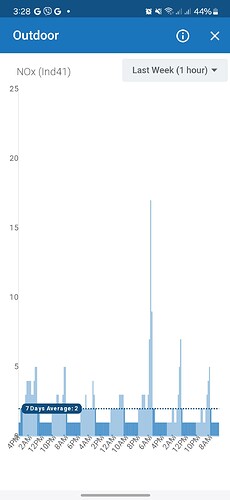Hi,
I’ve had an Airgradient outdoor unit running through the last week or so. Initially I purchased this to help investigate a burning smell observed in the area during the night. Please note that we are a kilometre or so away from a light industrial area.
I was expecting to see high PM emissions during the night hours however that was not the case. I am constantly measuring between 15-25 PM2.5 depending on the hour of day.
One thing that I noticed is that the NOx measurement spikes during the night and matches the pattern we observed with the burning odours. At the same time the NOx measurements are not precise and they just give you an arbitrary level above the baseline (being 1).
I am attaching a screenshot of the NOx measurements from the last week. Is there more information to know based on these? I.e. are the levels dangerous, what could be causing them, etc.
Any help is greatly appreciated.
